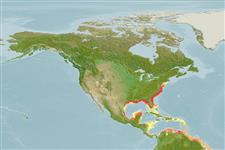Teleostei (teleosts) >
Eupercaria/misc (Various families in series Eupercaria) >
Sciaenidae (Drums or croakers)
Etymology: Sciaenops: Greek, skiaina, skion = a fish, red mullet + Greek, ops = appearance (Ref. 45335).
More on author: Linnaeus.
Environment: milieu / climate zone / depth range / distribution range
Ecology
Marine; brackish; demersal; oceanodromous (Ref. 51243); depth range 10 - ? m (Ref. 9988). Subtropical; 15°C - 26°C (Ref. 127841); 43°N - 0°S
Western Atlantic: Massachusetts in USA to northern Mexico, including southern Florida, USA.
Length at first maturity / Size / Weight / Age
Maturity: Lm 82.7, range 55 - 80.3 cm
Max length : 155 cm TL male/unsexed; (Ref. 3702); common length : 100.0 cm TL male/unsexed; (Ref. 3702); max. published weight: 45.0 kg (Ref. 9988); max. reported age: 50 years (Ref. 32563)
Occurs usually over sand and sandy mud bottoms in coastal waters and estuaries. Abundant in surf zone. Feeds mainly on crustaceans, mollusks and fishes. Utilized fresh and frozen; can be pan-fried, broiled and baked (Ref. 9988).
Robins, C.R. and G.C. Ray, 1986. A field guide to Atlantic coast fishes of North America. Houghton Mifflin Company, Boston, U.S.A. 354 p. (Ref. 7251)
IUCN Red List Status (Ref. 130435: Version 2024-1)
Human uses
Fisheries: minor commercial; aquaculture: commercial; gamefish: yes; aquarium: public aquariums
Tools
Special reports
Download XML
Internet sources
Estimates based on models
Preferred temperature (Ref.
123201): 15.5 - 27.3, mean 24.2 °C (based on 180 cells).
Phylogenetic diversity index (Ref.
82804): PD
50 = 1.0000 [Uniqueness, from 0.5 = low to 2.0 = high].
Bayesian length-weight: a=0.00832 (0.00523 - 0.01324), b=3.07 (2.94 - 3.20), in cm total length, based on LWR estimates for this species & (Sub)family-body (Ref.
93245).
Trophic level (Ref.
69278): 3.7 ±0.57 se; based on food items.
Generation time: 2.6 (2.4 - 3.7) years. Estimated as median ln(3)/K based on 16
growth studies.
Resilience (Ref.
120179): Medium, minimum population doubling time 1.4 - 4.4 years (K=0.27; tmax=7; Fec~1 million).
Fishing Vulnerability (Ref.
59153): Moderate vulnerability (44 of 100).
Climate Vulnerability (Ref.
125649): Very high vulnerability (88 of 100).
Nutrients (Ref.
124155): Calcium = 45.3 [25.8, 87.1] mg/100g; Iron = 0.905 [0.462, 1.579] mg/100g; Protein = 21.4 [18.9, 23.7] %; Omega3 = 0.262 [0.127, 0.506] g/100g; Selenium = 38.8 [20.5, 79.0] μg/100g; VitaminA = 4.2 [1.5, 14.5] μg/100g; Zinc = 0.566 [0.398, 0.828] mg/100g (wet weight); based on
nutrient studies.
